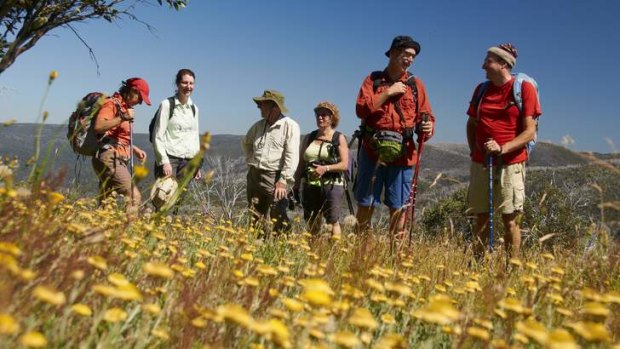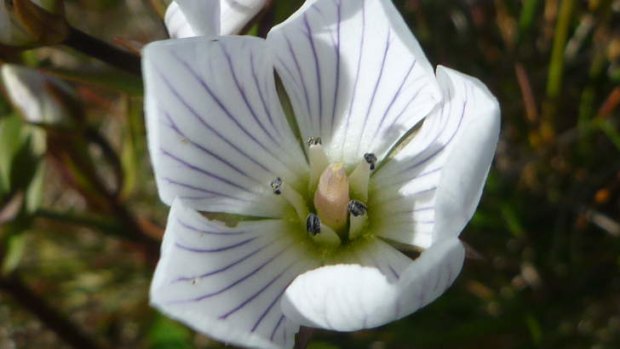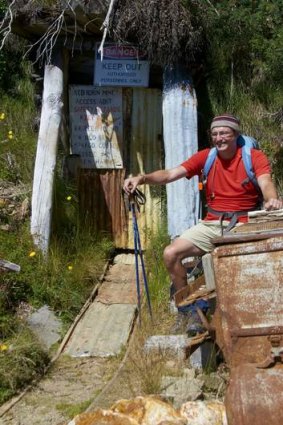
A welcome level spot on the climb from Cobungra Gap on the hike from Mount Hotham to Falls Creek.Credit: Melanie Ball
A steep hike in Alpine National Park takes in wildflowers, history and spell-binding vistas, writes Melanie Ball.
'The problem with mountains is all the hills." Voiced on the short, gentle ascent between the hotel where we have just filled up with pizza and the Falls Creek apartment where we will shortly raise the level of an outdoor spa by several body volumes, this comment triggers laughter all round.
And I laugh loudest, for we have come to Victoria's high country to hike from Mount Hotham to Falls Creek, and I may have flattened out the hills a little when touting the route to the speaker, my husband.

Mueller's snow gentians in bloom.Credit: Melanie Ball
Walking from Falls to Hotham early in 2008, a year after the summer bushfires that burnt over a million hectares of Australia's Alps, I experienced one of the best alpine wildflower seasons for decades, treading a trail through carpets of daisies. My memories of the colours and textures of the flowers and snow gums and the subtle variations in blues across the mountain ridges are so vivid that when a friend suggested a group walk, in the reverse direction, I eagerly agreed.
And so at 7am on a Saturday we clamber into a minivan outside Huski Luxury Apartments, seven friends from Melbourne's colonial dancing scene and a ring-in from central Victoria.
The complication of this hike is that unless you walk there and back over two days and stay overnight in the other alpine resort (or camp out if so inclined), you need transport at one end. Fortunately, Falls Creek operates a shuttle, hence our sparrow's-fart start down one mountain to drive up another.

Rest stop at Red Robin Mine.Credit: Melanie Ball
A stifling 38 degrees is forecast for Melbourne so the cold, cutting wind which flaps our sunhat brims when we exit the minibus at Mt Loch car park on Mt Hotham shocks everyone awake.
Our route, initially on the Australian Alps Walking Track (AAWT), which extends 650 kilometres from Walhalla to Namadgi National Park near Canberra, skirts ski lifts and downhill runs and gives photo-stop views back to Hotham Village.
But it's the view of the Razorback, a spine-like ridge running north to Mt Feathertop, Victoria's second highest peak after Mt Bogong (1986 metres), which demands and holds our attention as we enter Alpine National Park. (The walk along the Razorback to Feathertop is one of Victoria's best hikes.)
From up close we can see that most of the snow gums burnt in the 2006-2007 bushfires are reshooting from their roots, as this eucalypt species does, but from a distance the stubble of grey dead branches gives the mountains the look of a huge, recumbent silverback gorilla.
And the few extra metres of elevation attained by walking to the top of Mt Loch, 500 metres off the AAWT, broadens a vista that has already left me open-mouthed.
We continue along Machinery Spur to Red Robin Gap on a broad track bordered with striped snow gums and yellow rafts of everlastings and billy-buttons.
From the gap, a dirt road switchbacks steeply downhill to Red Robin Mine, a site registered by Heritage Council Victoria and the reason we have come this way. Solo prospector Bill Spargo discovered Red Robin reef in late 1940, triggering a rush. The mine, billed in early promotions as Victoria's highest and richest, has operated almost continuously since. Ken Harris has worked the mine since 1978 and his name adorns the door closing the adit cut into the hill.
A trailer towbar juts from a corrugated-iron hut built around the tray. There is a rusty ore skip and small boiler, and narrow-gauge tracks lead to a platform from which mined rock is tipped into the truck parked below. The road continues down, and down, into towering mountain ash, and I am glad of the walking poles easing the stress on my knees. The long descent means we have to regain the height we have lost. The up starts at a point marked on the map as Red Robin Battery.
But instead of the rusty old crusher I expect, there is only Harris's locked main camp.
We eat lunch roadside before beginning to climb. And we climb for the next couple of hours, steeply in places, gently in others, but steadily, the occasional flat areas and short descents producing moments of physical bliss.
Swapping road for walking track we climb to Cobungra Gap and rejoin the AAWT. At the junction we look up at the tree-less ridge where our walk began and down at Dibbins Hut, the most recent of several shelters built at the head of the Cobungra River since the Dibbins brothers from Freeburgh, near Bright, established a cattle run here in 1900.
Everyone sets a different pace as we climb back into snow gums. And everywhere are flowers; photographing massed yellow and white everlastings, golden billy-buttons, royal bluebells, stalks of pink grass trigger-plants and strings of pale-vanilla lilies gives me additional excuses to stop and rest.
Snow gum forest has a sculptural beauty dramatically different from that of the high plains on which the track deposits us mid afternoon, where the open space makes you feel small, insignificant even.
We share this expanse with two mobs of brumbies. The first, a group of five, moves off as we stride out along the track. The second is a stallion and two mares grazing only 50 metres or so from the trail when I first see them.
Stopping to photograph the plains and the posies of Mueller's snow gentians has put me behind the lead walkers, although they are in sight, but still well ahead of the last four. I am effectively on my own when the horses suddenly loom large in my viewfinder, twitching their ears and swishing their tails.
Fearing the stallion is about to charge, I wave my walking poles and walk on and away from them.
Snow poles that were barely visible among the trees march across the high plains in military single file, their number tags counting us down to the trail junction where we again leave the AAWT.
Pretty Valley Pondage, where we parked two cars the previous night to save us a 6 kilometre road-and-track trudge to Falls Creek village, is 2 kilometres directly ahead but the walking trail does a lengthier dogleg. The final hill drains our remaining energy.
It also seems longer than the 3 kilometres marked on the map, which convinces me that our map is of the Hogwarts variety and changes at will and whim.
The fastest in our group complete the 22.5 kilometre walk in 8½ hours. The backmarkers reach Pretty Valley's grassy shore 10 hours after setting out. But we are all equally weary. Satisfied. Proud even. But weary.
Everyone in our car voices a preference for a different internal alcohol rub as we drive towards food and a therapeutic under-the-stars spa. To secure both we just have to scale our accommodation's steep, stone front steps - last of the mountain's problematic hills.
TRIP NOTES
GETTING THERE
Falls Creek is a 390-kilometre drive (about 5 hours) from Melbourne via the Hume Fwy and Mt Beauty. QantasLink flies daily from Sydney to Albury, see qantas.com. You can book a coach from Albury Airport to Falls Creek, see fallscreekcoachservice.com.au.
WALKING THERE
A map of day walks is available from the Visitor Information Centre but you need a contour map to walk between Falls and Mt Hotham. Shuttles are booked through the information centre (03) 5758 1202, fallscreek.com.au.
MORE INFORMATION
Sign up for the Traveller Deals newsletter
Get exclusive travel deals delivered straight to your inbox. Sign up now.